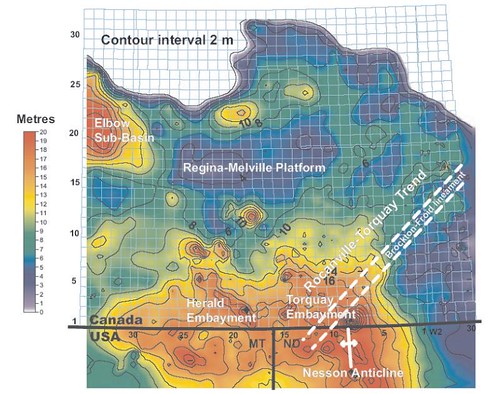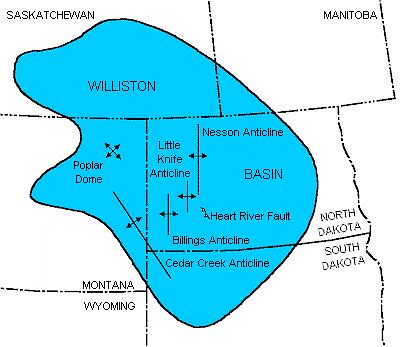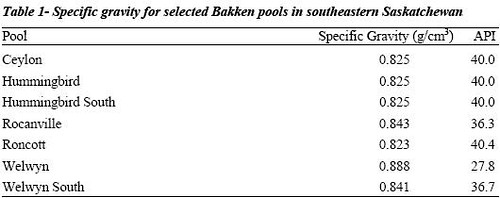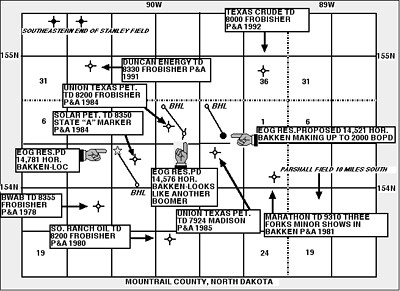That means that the Bakken oil is more than the Pembina's reserves, which were estimated to contain 7.8 billion barrels of oil, of which 1.6 billion were recoverable. To date, more than 1.2 billion barrels have been produced and it's still going strong. Big oil, say the engineering types, gets bigger.
If this oil formation plays out toward the higher end of size and recoverability then it will change the geopolitics of oil and the economies of the United States and Canada. If a lot of the oil proves difficult to recover now, new technologies could still drastically improve the percent recoverable. The motivation to pull out another 100 billion barrels would be $9 trillion at todays prices.
Estimates are anywhere from a conservative 25 billion barrels of oil in place, to a high estimate by the United States Geological Survey of 400 billion barrels of oil in the Bakken formation. Not only is the oil plentiful, but it's high quality too, 41 degree light sweet crude. The Bakken formation is a formation of black shale, siltstone, and sandstone. The formation lies beneath the Mississippian formation, Saskatchewan's current source of light sweet crude. The Bakken formation is situated beneath southeastern Saskatchewan, southwestern Manitoba, and North Dakota.
In 2007, EOG Resources out of Houston, Texas reported that a single well it had drilled into an oil-rich layer of shale below Parshall, North Dakota is anticipated to produce 700,000 barrels of oil.
The resources of the Bakken Formation are defined by the United States Geological Survey (USGS) as unconventional “continuous-type” oil resources. This means the hydrocarbons within the Bakken have not accumulated into discrete reservoirs of limited areal extent. With new horizontal drilling and completion technology taken into account, the technically recoverable resource base for the entire Bakken Formation is potentially much larger.

Isopach map of the Bakken formation in Saskatchewan, Canada (Map of the areal extent and thickness variation of a stratigraphic unit; used in geological exploration for oil and for underground structural analysis)

The Williston Basin covers approximately 300,000 square miles over parts of North Dakota, South Dakota, and Montana and parts of the adjacent Canadian provinces of Saskatchewan and Manitoba. The Bakken formation can be encountered throughout the Williston Basin.
Application of new drilling and completion technology has begun to unlock new potential in this legacy basin. There is speculation that the total resource in the play could be in the billions of barrels.
Hydrocarbon Potential of the Bakken and Torquay Formations,
Southeastern Saskatchewan by L.K. Kreis and A. Costa
Much of the oil reservoired within the Bakken shale likely resides in a network of enhanced porosity and permeability related to microfractures.
• Upper and Lower Bakken shales showing anomalously high resistivity values in southeastern Saskatchewan suggest that they are saturated with oil that has either been generated in place or has migrated into these locations.
• Basement structures, such as those associated with the Brockton-Froid lineament, and compactional features in regions of Middle Devonian salt dissolution may control fractures that serve as primary migration pathways for Bakken-sourced oils into possible plays in the Bakken and Torquay formations.
• The relatively low permeability of Bakken and Torquay reservoirs are likely best exploited through horizontal wells.
• A large untested and poorly evaluated rock volume remains in the Bakken and Torquay formations of southeastern Saskatchewan, within which there may be significant potential for finding new oil.
Porosities in the Bakken average about 5%, and permeabilities are very low, averaging 0.04 millidarcies—much lower than typical oil reservoirs. However, the presence of horizontal fractures makes the Bakken an excellent candidate for horizontal drilling techniques in which a well drills along the extent of the rock layer, rather than punching a hole vertically through it. In this way, many thousands of feet of oil reservoir rock can be penetrated in a unit that reaches a maximum thickness of only about 140 feet. Production is also enhanced by artificially fracturing the rock.

Oils with an API gravity of 40 to 45 have the highest market price and those with values outside this range sell for less. Above an API gravity of 45, the molecular chains become shorter and are less valuable to a refinery. Crude oil classified as light, medium or heavy, on the following basis:
Light crude oil has an API gravity of above 31.1 °.
Medium oil has an API gravity in the range 22.3 ° and 31.1 °.
Heavy oil has an API gravity less than 22.3.
FURTHER READING
In 1992, Energy and Mines estimated there was roughly 100 billion barrels of oil in the Bakken formation throughout the entire Williston Basin.
Dancsok, who co-authored the 1991 study, said the prevailing view in the geoscience community at the time was "the potential of the Bakken was immense, but the price of oil in 1991 was not such that people wanted to risk (exploration and development dollars)."
Dancsok estimated roughly 25 per cent of the Williston Basin, which covers some 200,000 square miles (518,000 square kilometres) is located in Saskatchewan. Based on that simple arithmetic, the estimate of Bakken oil in the province could range anywhere from 25 billion barrels to 100 billion barrels of oil in place.
Of course, geology isn't that simple.
"Whether the Bakken is evenly distributed throughout the basin is one question," Dancsok said. "It is deeper in North Dakota. But is the distribution of Bakken oil equal in Saskatchewan to North Dakota or Montana? That's a big question mark."
Research documents for purchase from the Saskatchewan government
North Dakotas Bakken Reserve estimates
New estimates of the amount of hydrocarbons generated by the Bakken were
presented by Meissner and Banks (2000) and by Flannery and Kraus (2006). The first of
these papers tested a newly developed computer model with existing Bakken data. Data
used was not as extensive as some of the other studies mentioned in this discussion
therefore estimates of generated oil presented were 32 BBbls. The second paper by
Flannery and Kraus used a more sophisticated computer program with extensive data
input supplied by the ND Geological Survey and Oil and Gas Division. Early numbers
generated from this information placed the value at 200 BBbls (pers. comm. Jack
Flannery, 2005). Estimates had been revised to 300 BBbls when the paper was presented
in 2006. Even if the lower value of 32 BBbls is correct, the amount that may be
potentially recovered from the Bakken is significant.
How much of the oil that has been generated is technically recoverable is still to
be determined. Price places the value as high as 50% recoverable reserves. A primary
recovery factor of 18% was recently presented by Headington Oil Company for their
Richland County, Montana wells. Values presented in ND Industrial Commission Oil
and Gas Hearings have ranged from 3 to 10%. The Bakken play in the North Dakota side
of the basin is still in the learning curve. North Dakota wells are still undergoing
adjustments and modifications to the drilling and completion practices used for this
formation. It is apparent that technology and the price of oil will dictate what is
potentially recoverable from this formation.
New cheap computer modeling could allow access to about 218 billion barrels of oil that is still in the ground in the USA in old wells and less economical fields.
Microwave oil recovery could make it cheaper to extract a lot more oil from oil shale (up to 800 billion barrels in the USA extractable) and from the oil sands. (Up to 2 trillion barrels in Canada's oilsands.
Al Fin also has a feature on the Toe to Heel Air Injection (THAI) technology for extracting oil from tar sands deposits.
A posting and msg board related to the EOG Resources well
EOG resources website
In the United States EOG’s total crude oil and condensate production increased 23 percent compared to the same quarter a year ago, driven by continued drilling success in North Dakota and the Mid Continent.
EOG announced 2008 total company production growth targets, ranging from 13 to 17 percent, depending on drilling economics and North American natural gas prices. Production growth in 2008 will be driven by United States operations, particularly the Fort Worth Basin Barnett Shale natural gas and the North Dakota Bakken crude oil plays, both very high rate of return programs
2007 EOG Resources SEC filings
In the United States, EOG's total crude oil and condensate production increased 23 percent compared to the same quarter a year ago, driven by continued drilling success in North Dakota and the Mid Continent.
In Mountrail County, North Dakota, EOG has reported successful drilling from the Bakken Formation. The Wenco #1-30H, in which EOG has a 52 percent working interest, was completed to sales at the end of September at an initial production rate of 1,930 barrels of oil per day (Bopd), gross. Also in Mountrail County, the Austin #1-02H was completed to sales in October at an initial production rate of 2,000 Bopd. EOG has a 100 percent working interest in the well, which is located nine miles north of existing production. This is the northernmost location that EOG has drilled to date. To further confirm the northern extension of the field, following completion of the Austin #1-02H, EOG drilled an offset well, the Austin #2-03H that will be completed in November. Based on shows during drilling, EOG expects the well to produce at a rate similar to that of the Austin #1-02H. EOG has an 81 percent working interest in the Austin #2-03H. In the North Dakota Bakken Play, where it has accumulated over 175,000 net acres, EOG plans to increase drilling activity from six to eight rigs in early 2008.
"The results from the two Austin wells have given us the confidence to increase estimated reserves in the Bakken Play from the previously announced 60 million barrels of oil to approximately 80 million barrels, net to EOG. By extending the perimeter of the field, we have also increased our inventory of firm drilling locations. Therefore, we expect this area to have a significant impact on EOG's oil production in 2008 and beyond. The Bakken is currently the highest rate of return play in our drilling program," said Mark G. Papa, Chairman and Chief Executive Officer
North Dakota Bakken
Zacher 1-24H - EOG has a 75 percent working interest in the Zacher 1-24H that was completed in June with a peak production rate of 1,774 barrels of oil per day (Bopd), gross.
Hoff 1-10H - EOG has a 75 percent working interest in the Hoff 1-10H, which began flowing to sales in June at a peak rate of 2,034 Bopd, gross.
N&D 1 - 05H - EOG holds a 67 percent working interest in the N&D 1-05H, which was completed in July at an initial peak production rate of 1,610 Bopd, gross.
Rocky Mountain Oil Journal: EOG Confirmed to Have Significant Producer North of Parshall Field
EOG Resources (EOG) has confirmed that its wildcat 10 miles north of Parshall Field is a large volume, horizontal Bakken producer. According to EOG’s 2007 Third Quarter results, the Austin #1-02H, a single-lateral test in the sw-se 2-154n-90w, Mountrail County, has been producing at an initial rate of 2,000 bopd. EOG has a 100 percent working interest in the #1-02H. Parshall Field is the largest Bakken oil pool discovered in North Dakota with a monthly production exceeding 200,000 bo. The company believes that this well is connected to Parshall Field, and if geological data supports this, Parshall Field could be a Class A oil field (100 mmbo +). Not only did EOG confirm the huge rates on the Austin #1-02H, the company also said that its first stepout to this well, the Austin #2-03H sw-se 3-154n-90w, will also produce at similar rates based on shows encountered during the drilling of this well. The #2-03H scales about one mile west of the of the 1-02H.

drillers added fracture technology to horizontal drilling. In fracture technology, mud is forced into the drilled hole under immense pressures to "frack" or break up the shale further. The deeper cracks allow more oil to flow to the pipe
No comments:
Post a Comment